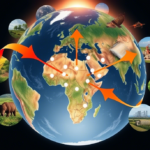Spotlight News
- Home
- Spotlight News


- Researchers at Karolinska Institutet and KTH have developed a computational method that can reveal how cells change and specialize in the body. The study, which has been published in the journal PNAS, can provide important knowledge about why this process sometimes goes wrong and leads to disease.
- A never-before-seen image of individual oxygen atoms dissolved in water has been captured.
- A research team has investigated long-term X-ray variability in the neutron star NGC 7793 P13, an object thought to be driven by supercritical accretion, where an extraordinary amount of gas falls onto the object and emits intense X-rays. The team found a relation between the X-ray luminosity and the rotation velocity, which could provide clues to reveal the supercritical accretion mechanism.
- Rocky planets like our Earth may be far more common than previously thought, according to new research published in the journal Science Advances. It suggests that when our solar system formed, a nearby supernova (the massive explosion of a star near the end of its life) bathed it in cosmic rays containing the radioactive ingredients to make rocky, dry worlds. This mechanism could be ubiquitous across the galaxy.
- Tropical storms such as typhoons, hurricanes, and cyclones are Earth's most powerful weather systems. Born over warm oceans, they travel thousands of kilometers to land, traversing waters now polluted with plastics, from coastal runoff to the vast oceanic garbage patches.
- Glacial earthquakes are a special type of earthquake generated in cold, icy regions. First discovered in the Northern Hemisphere more than 20 years ago, these quakes occur when huge chunks of ice fall from glaciers into the sea.
- An international team of scientists have identified nine new species of butterflies using a combination of geographical, morphological and molecular analysis.
- The cells of all animals—including humans—are characterized by their ability to adhere particularly well to surfaces in their environment. This mechanically stable adhesion enables the development of complex tissues and organs and is made possible by certain cell surface receptors called integrins. However, it is unclear how this form of cell adhesion developed over the course of evolution, as many single-celled organisms do not have integrin receptors.
- Liquids and solutions are complex environments—think, for example, of sugar dissolving in water, where each sugar molecule becomes surrounded by a restless crowd of water molecules. Inside living cells, the picture is even more complex: tiny liquid droplets carry proteins or RNA and help organize the cell's chemistry.
- For much of my career, I have been fascinated by the ways in which materials behave when we reduce their dimensions to the nanoscale. Over and over, I've learned that when we shrink a material down to just a few nanometers in thickness, the familiar textbook rules of physics begin to bend, stretch, or sometimes break entirely. Heat transport is one of the areas where this becomes especially intriguing, because heat is carried by phonons—quantized vibrations of the atomic lattice—and phonons are exquisitely sensitive to spatial confinement.
- In a new study published in Nature Physics, researchers have achieved the first experimental observation of a fragile-to-strong transition in deeply supercooled water, resolving a scientific puzzle that has persisted for nearly three decades.
- Scientists have found a way to turn carbon dioxide and methane, the two most notorious greenhouse gases, into useful chemicals without any expensive catalysts, using only light.
- Imagine wearable health sensors, smart packaging, flexible displays, or disposable IoT controllers all manufactured like printed newspapers. The same technology could underpin communication circuits, sensors, and signal-processing components made entirely from solution-processed 2D materials.
- If mistletoe's status as a nutrient-stealing freeloader has been cooling your holiday ardor, new research led by an Oregon State University scientist may help relight the fire.
- Imagine holding a narrow tube filled with salty water and watching it begin to freeze from one end. You might expect the ice to advance steadily and push the salt aside in a simple and predictable way. Yet the scene that unfolded was unexpectedly vivid.
- From claims that vaccines don't work to manipulated images and deliberately misrepresenting what politicians say, social media is often rife with misinformation. But far from being a recent phenomenon, there is nothing new about so-called "fake news," according to a new paper published in the journal Interface. Researchers argue that misinformation is an inherent and inevitable property of biological systems, from bacteria to birds and human societies.
- This week, researchers identified signaling pathways underpinning drug resistance in pancreatic cancer, a normally lethal diagnosis. A physicist proposed that conscious states in the brain may arise from the brain's ability to resonate with the quantum vacuum that permeates space. And in a ranking of species monogamy, humans came in between meerkats and beavers.
- Gemini North captured new images of Comet 3I/ATLAS after it reemerged from behind the sun on its path out of the solar system. The data were collected during a Shadow the Scientists session—a unique outreach initiative that invites students around the world to join researchers as they observe the universe on the world's most advanced telescopes.
- Viruses are typically described as tiny, perfectly geometric shells that pack genetic material with mathematical precision, but new research led by scientists at Penn State reveals a deliberate imbalance in their shape that helps them infect their hosts.
- Canine induced pluripotent stem (iPS) cells possess the ability to differentiate into any type of cell, making them a useful tool for investigating common canine diseases and disease states, including those of humans.
Photographer:








